![]() — Russkiy Mir Foundation — Journal — Articles — Four Names
— Russkiy Mir Foundation — Journal — Articles — Four Names
 Four Names
Four Names
Monuments are not set up for no reason, and that was especially the case in the second century A.D. and especially to a mortal woman, not a goddess. Here, in ancient Chersonese Taurica, almost 2,000 years ago, a monument was put up to a woman on behalf of the people’s assembly of this city.
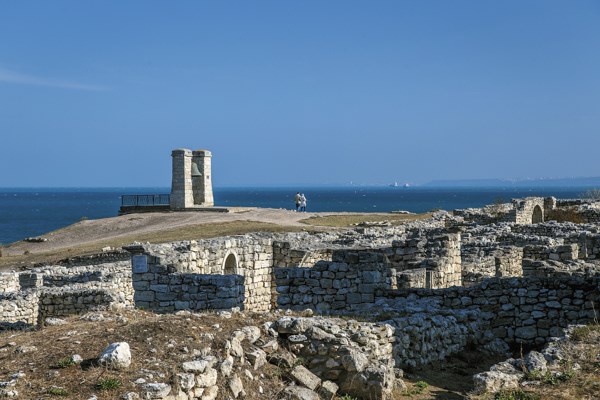 Her name was Elia Laodice, which has a tender and melodic ring – like a soft breeze plucking the strings of the lyre forgotten by a graceful girl on the rocky cliff of the Black Sea…
Her name was Elia Laodice, which has a tender and melodic ring – like a soft breeze plucking the strings of the lyre forgotten by a graceful girl on the rocky cliff of the Black Sea…But our imagination can get out of hand with such sweet things. Cold hard facts tend to be less romantic, as passionless as the stone walls of ancient Chersonesus. Speaking of facts, everything we know about Elia Laodice can be packed in a couple of lines. She was born into a noble family, married Titus Flavius Partenocles, while her mortuary urn was found during the Chersonesus excavation in the family crypt at the city rampart.
We do not know what inspired her fellow citizens to put up a monument to Partenocles’ wife: her beauty, heroism or self-sacrifice? We do not even know how old Laodice was when her loved ones kindled the funeral fire. There are more questions than answers in her story as well as in the history of her city…
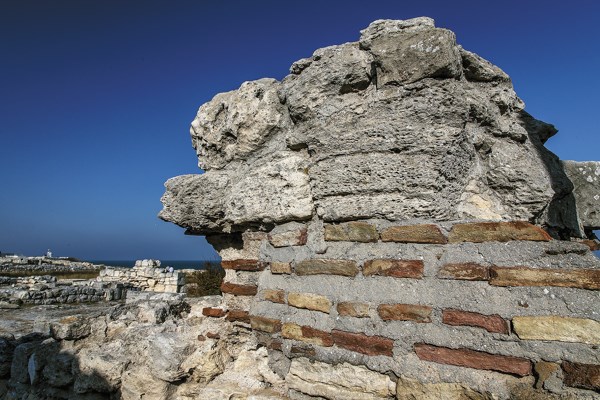 As a matter of fact, light breezes are a rare thing here. More often this site is exposed to fierce maritime winds, whistling in the ears, stealing your scarf away, disheveling your hair, at the same time blowing away the image of an elegant girl with a lyre from your mind. And then, standing on a vertical cliff, with the Black Sea waves breaking tirelessly, you recall that among the women named Laodice, known to you from the Greek history and mythology – from Electra Laodice to Queen of the Kingdom of Pontus Laodice VI – there were heroines, shameless intriguers and even child killers…
As a matter of fact, light breezes are a rare thing here. More often this site is exposed to fierce maritime winds, whistling in the ears, stealing your scarf away, disheveling your hair, at the same time blowing away the image of an elegant girl with a lyre from your mind. And then, standing on a vertical cliff, with the Black Sea waves breaking tirelessly, you recall that among the women named Laodice, known to you from the Greek history and mythology – from Electra Laodice to Queen of the Kingdom of Pontus Laodice VI – there were heroines, shameless intriguers and even child killers…But you should only look back, see the ruins of Chersonesus – and those suspicions vanish: too eloquent are these stones overgrown with gray lichen! You just need to strain your imagination – what could we do without it anyway? – and lo, coming out of the thin air is the brilliant polis known under four different names: Tauric Chersonese, Chersonesus, Sarsona and Korsun. True, it was founded later than other Greek cities on the Crimean Peninsula, but it is this city that was blessed with the most amazing, tempestuous and remarkable fate…
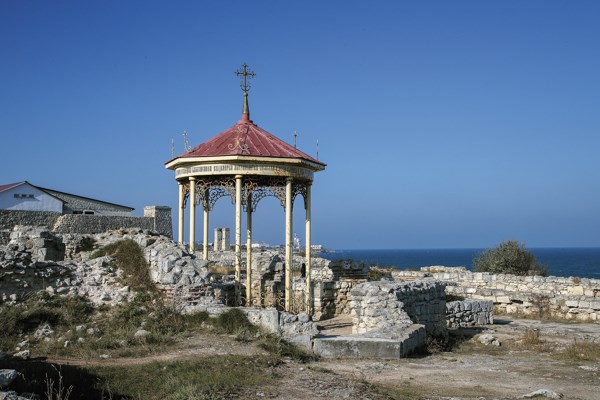 Greeks who arrived at this rocky coast 25 centuries ago did not rack their brains long over the name for their new homeland and called the future city Peninsula, which in Greek is Chersonesus. Why? Because this is where they disembarked from their vessels!
Greeks who arrived at this rocky coast 25 centuries ago did not rack their brains long over the name for their new homeland and called the future city Peninsula, which in Greek is Chersonesus. Why? Because this is where they disembarked from their vessels! Judging by the abundance of Chersonesus place-names, scattered over the shores of different seas, ancient Greeks were not extremely inventive as they came up with a name of another colony or discovered peninsula. To avoid confusion, they defined by means of a geographic adjective, what particular Chersonesus they meant. For instance, today’s Gallipoli in Turkey was known in antiquity as Chersonesus Thracica. Marmarica in Maghreb bore the proud name of Chersonesus the Great, while the Chersonesus founded on the south-western shore of the Crimea was known as Chersonese Taurica. For the same plain reason the tribes populating the Crimea in those days were described as people of Taurus by Greeks. They had a rather unsavory reputation as fierce people and robbers, offering human sacrifices to their fertility goddess.
Frankly, the Greeks who founded Chersonesus in the V century B.C. did not care much. The great Greek colonization had already spilled beyond the Mediterranean confines: land was always in short supply there. Socrates caustically noted that “Greeks settled down across the Mediterranean like frogs round a swamp.” So neither the fierce people of Taurus nor the Euxine (ancient Greeks described the Black Sea as “inhospitable”) were considered by colonizers as the reasons for halting the expansion…
Union of the opposites
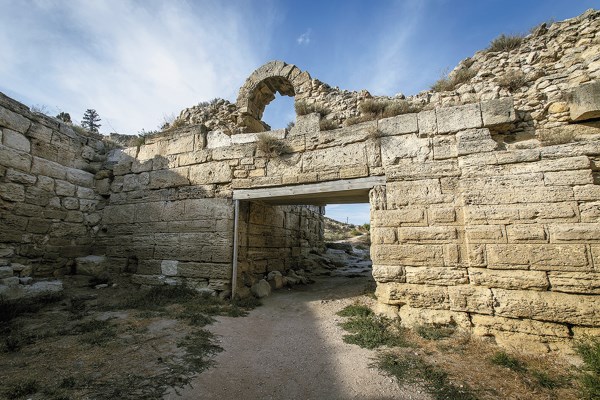 It’s best to arrive right at the opening the museum preserve Chersonese Taurica, before noisy tourists have filled the grounds of the ancient town. Then you’ll be lucky to roam the ruins in solitude, turning your ear to the insistent summons of the waves and wistful shrieks of sea-gulls. And be sure to begin your stroll with the Port quarter where Chersonesus originated. It is here that newcomers from Heraclea of Pontus and the island of Delos settled down.
It’s best to arrive right at the opening the museum preserve Chersonese Taurica, before noisy tourists have filled the grounds of the ancient town. Then you’ll be lucky to roam the ruins in solitude, turning your ear to the insistent summons of the waves and wistful shrieks of sea-gulls. And be sure to begin your stroll with the Port quarter where Chersonesus originated. It is here that newcomers from Heraclea of Pontus and the island of Delos settled down.There is some strange glamour in that union of colonists from two Greek cities, so let’s dwell a bit on this mix.
Heraclea of Pontus was one of the most thriving places of Bithynia. But neither the excellent harbor, nor trade that made the denizens wealthy, nor Heraclitus, Plato’s disciple, made it so glorious. The city stood at the river Acheron which, flowing through Acherusian Lake, then disappeared underground. Should we recall that Acheron, the river of sorrow, was venerated by ancient Greeks as one of the five rivers of Hades? While the somber gorge where it disappeared underground was believed to be the entrance to the Underground Realm. Here from Time Immemorial Greeks paid homage to the dead, conjuring their shadows. Therefore Heraclea of Pontus was the last frontier on the way to the abode of the dead.
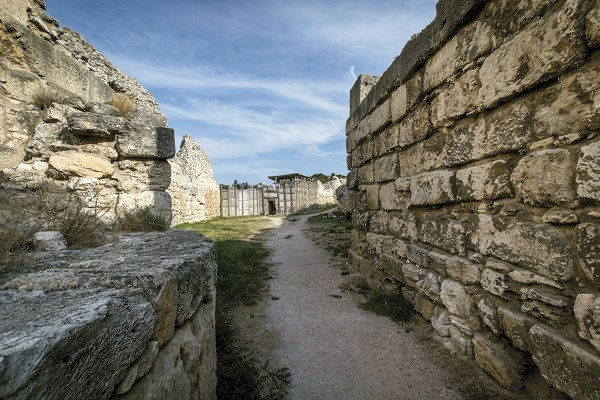 And Delos was a sort of antipode to Heraclea. Greeks were confident that it is here, in the smallest of Cyclades, that majestic twin gods were born: moon-faced Artemis and sunny Apollo. Surely that island was thought to be a holy place. The city of Delos located there did not even have any ramparts: the local inhabitants were not anxious about their safety, resting in blessed assurance that the sacredness of the place was their best guard. Yet the sacred status was also fraught with some inconveniences: the dead could not be buried in Delos, so people of Delos had to bury their dead in the neighboring island of Rhenea (Rinia), while Delos was solely the island of the living.
And Delos was a sort of antipode to Heraclea. Greeks were confident that it is here, in the smallest of Cyclades, that majestic twin gods were born: moon-faced Artemis and sunny Apollo. Surely that island was thought to be a holy place. The city of Delos located there did not even have any ramparts: the local inhabitants were not anxious about their safety, resting in blessed assurance that the sacredness of the place was their best guard. Yet the sacred status was also fraught with some inconveniences: the dead could not be buried in Delos, so people of Delos had to bury their dead in the neighboring island of Rhenea (Rinia), while Delos was solely the island of the living.Guards from the realm of the dead and people inhabiting the island of the living, joining hands for the sake of founding a new colony on the foreign shore is a promising prelude to a legend. But symbolic images aside, one has to admit there were hardly any mystic elements in the union of Heraclea and Delos. Almost at the same time Heraclea was stricken by a political crisis resulting in a conflict between Aristocrats and Democrats, while Delos had to repel the claims of Athens to hegemony. Democrats in Heraclea lost and had to leave their native city; the same fate befell those people of Delos who opposed the dictate of Athens. Ousted citizens of Heraclea sought the advice of the famous Delphic oracle who prophesied that they would populate the Tauric Peninsula along with people of Delos, which they did eventually. Of course, nobody waited for them there: local tribes were not going to share their lands. So it did not take long before the colonists had to erect ramparts to secure themselves against the inroads of Taurians and Scythians. Nevertheless, the tempestuous history of Chersonesus never allowed builders to sit idle: the defensive fortifications were rebuilt and reinforced almost constantly. The outcome is impressive even today, when not too much is left from the ramparts.
From republic to empire
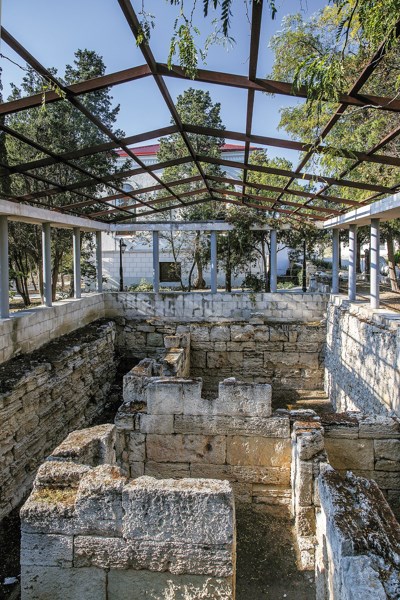 Archaeologists believe that by the early II century A.D. a proteichisma, an additional front wall, was erected in front of the main rampart on its most vulnerable lengths. The proteichisma complicated the use of siege weapons by foes. And even if the latter got over it they would land in a trap called a peribolos, that is, an open space between the front wall and the main wall. In this case assailants would themselves in a stone trap, squeezed between two walls, with stones, arrows and spears thrown at them and boiling resin poured on their heads.
Archaeologists believe that by the early II century A.D. a proteichisma, an additional front wall, was erected in front of the main rampart on its most vulnerable lengths. The proteichisma complicated the use of siege weapons by foes. And even if the latter got over it they would land in a trap called a peribolos, that is, an open space between the front wall and the main wall. In this case assailants would themselves in a stone trap, squeezed between two walls, with stones, arrows and spears thrown at them and boiling resin poured on their heads. For the time being Chersonesus successfully overpowered its enemies and quickly secured prosperity: the people of Chersonesus proved to be enterprising intermediaries. From Greece they brought here the goods which were in high demand among the locals: jewelry, weapons, olive oil, black lacquered dishes… And they exported furs, honey, wax, leathers, bread, slaves, and certainly fish and garum! It’s no coincidence that several houses and estates of fish traders were found by archeologists in Chersonesus, along with huge fish-storing cisterns and even the opsopolion – a fish market where fish sauces were sold. It’s easy to imagine the neighbors of wealthy fish dealers, in whose homes that very pungent garum was prepared, cursing their own wretched fate. The sauce was unusually popular in antiquity and was served both for sweet and salty dishes – it was even used as a remedy. Thank God that before squandering all his fortune away on delicatessen and committing a suicide after realizing that he would have to eat plain food, the famous Roman gourmand Marcus Gavius Apicius left a recipe book where he did not forget to mention garum. Thanks to him, we know that the main ingredients of that sauce were fish, olive oil, vinegar, salt, wine and herbs. Sounds good, but the point is that this mixture was left to rot in the sun for 2-3 months. Can you imagine the odor this exquisite delicatessen exuded? So all the passion for garum notwithstanding, a ban was imposed in on its production big cities of ancient Rome …
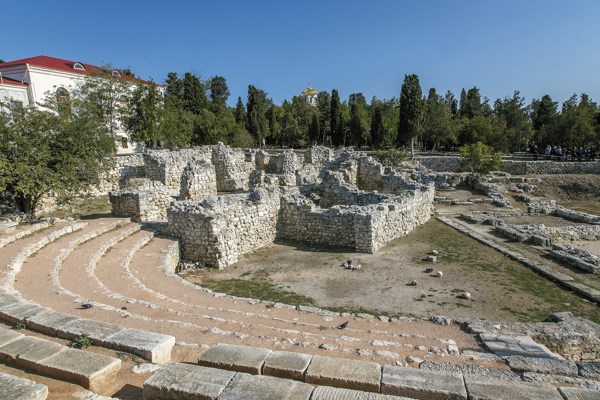 Wealthy Chersonesus overgrown with new territories was thriving, having turned into a slave-owning republic, with an assembly of citizens being its supreme body. The annually reelected council dealt with the economy, business and current affairs and everything was overseen by a collegiate of nomophylakis – “law guards”. The city planned in accordance with the Hyppodamus system went on sprawling and in the III century B.C. even a theater appeared therein. After that it was difficult to treat Chersonesus as a sleepy little town. Most likely it is in that theater that local historian Syriscus was reciting his work for his fellow citizen, wherein he portrayed the inroads of Barbarians on Chersonesus. The treatise of this honored man did not come down to us; however a decree informing that Syrisk was awarded a gold crown during the Dionysia celebration can still be seen carved out on marble.
Wealthy Chersonesus overgrown with new territories was thriving, having turned into a slave-owning republic, with an assembly of citizens being its supreme body. The annually reelected council dealt with the economy, business and current affairs and everything was overseen by a collegiate of nomophylakis – “law guards”. The city planned in accordance with the Hyppodamus system went on sprawling and in the III century B.C. even a theater appeared therein. After that it was difficult to treat Chersonesus as a sleepy little town. Most likely it is in that theater that local historian Syriscus was reciting his work for his fellow citizen, wherein he portrayed the inroads of Barbarians on Chersonesus. The treatise of this honored man did not come down to us; however a decree informing that Syrisk was awarded a gold crown during the Dionysia celebration can still be seen carved out on marble. But soon Chersonesus bumped into the first serious problem. Scythians, who had more than once filled Greeks with consternation before, fashioned their new capital Neapolis (modern-day Simferopol) in dangerous proximity to Chersonesus and then started persistently conquering back lands from the Greeks: in the II century B.C. Chersonesus lost some of its possessions and was forced to seek protection from the Bosporan Kingdom (holding the eastern part of the Crimean Peninsula, with the capital in Panticapaeum, modern-day Kerch), with legendary Mithridates VI sitting on its throne at the time. The forces of Mithridate smashed Scythians, but Chersonesus had a high price to pay for this aid. It lost its independence and ended up paying tribute to the Bosporan ruler, though for a long time: ambitious Mithridate declared a war on Rome, was totally defeated and smashed by famous Gneus Pompeus in three bloody battles, and soon after committed a suicide. And Chersonesus in the first century B.C. came under the banners of Rome – Gaius Julius Caesar assigned a special status to the city and from then on it was directly subject to the Roman administration. So until the Roman Empire was divided into the Western and Eastern kingdoms, the soldiers of the First Italian, XI Cladius and V Macedonian Legions had alternately been quartered in the Chersonesus citadel while anchored in the harbor were the ships of the famed Flavius Fleet…
Under the Cross sign
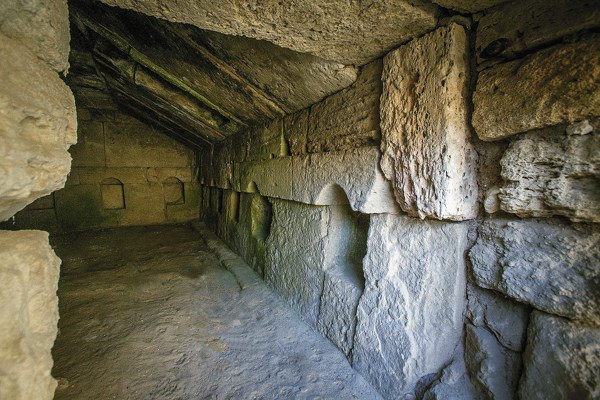 In nearly every part of Chersonesus it is possible to find the ruins of a Christian church or chapel. Even on the orchestra of the city theater, where originally tragedies and comedies had been staged and gladiators had fought in the years of Roman dependence, two churches were later built and the ruins can be seen today.
In nearly every part of Chersonesus it is possible to find the ruins of a Christian church or chapel. Even on the orchestra of the city theater, where originally tragedies and comedies had been staged and gladiators had fought in the years of Roman dependence, two churches were later built and the ruins can be seen today.Christian believers had appeared in Chersonesus long before the Roman Empire disintegrated and the city fell under the power of Byzantium. As early as in the first centuries A.D. followers of Jesus were exiled to Chersonesus or rather to the nearby Inkerman Quarry. We do not know the number of exiles, or how many of them perished from hard work at Inkerman, but it is a known fact that at the end of the first century A.D. one of the 70 disciples of Christ and fourth Pope of Rome Saint Clement I was exiled here. Together with other exiles he worked at the quarries and went on preaching among the Gentiles. According to the hagiography of Saint Clement, he sometimes baptized up to 500 people a day. Eventually a special envoy of Emperor Trajan arrived in Chersonesus, to make a short work of Clement. He tortured Saint Clement for a long time and then ordered him to be tied up to an anchor and drowned in the sea.
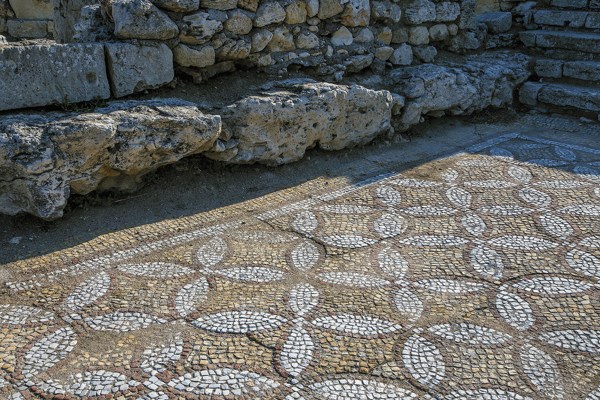 However strange this may seem, the next Pope of Rome who fell into disgrace appeared in Kherson at the time, when Christianity had long been the official religion of Byzantium. Five centuries after the murder of Saint Clement, the 74th Bishop of Rome, Saint Martin I was exiled to Chersonesus and died there in 655 A.D. The elderly pontific roused the anger of Byzantine Monothelite Emperor Constans II, decrying the Monothelite heresy at the Lateran Council of 649 A.D. This cost him his Tiara and his life.
However strange this may seem, the next Pope of Rome who fell into disgrace appeared in Kherson at the time, when Christianity had long been the official religion of Byzantium. Five centuries after the murder of Saint Clement, the 74th Bishop of Rome, Saint Martin I was exiled to Chersonesus and died there in 655 A.D. The elderly pontific roused the anger of Byzantine Monothelite Emperor Constans II, decrying the Monothelite heresy at the Lateran Council of 649 A.D. This cost him his Tiara and his life.And slightly more than 200 years later saints Cyril and Methodius equal to the Apostles, creators of the old Slavic alphabet, arrived in Chersonesus. In 860 A.D. Byzantine Emperor Michael III sent them on a mission to the Khazar khagan. In the previous century Khazars with their capital in Ityl (today’s Astrakhan region) conquered back part of the Crimea from Byzantium and continued threatening the empire, so Constantinople preferred to make the Khaganate its ally. Khazars adhered to Judaism, but in the IX century Christianity and Islam began their inroads to the Khaganate. Theological disputes were among the entertainments mostly beloved by the rulers, and so it’s no wonder that the khagan sent his envoys to Constantinople, having suggested that Michael III send a scholar to Ityl. According to the Hagiography of the Saintly brothers, the khagan’s letter read: “If he prevails over Jews and Saracens in a dispute we’ll be converted to your faith.”
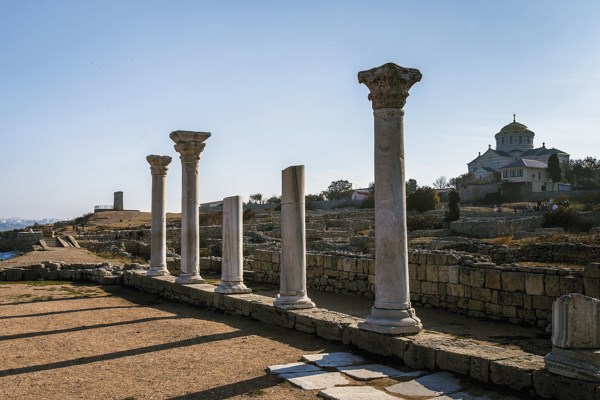 The mission led by Cyril included his brother Methodius as well. Preparation for the mission was under way in Chersonesus, where the Byzantine missionaries arrived only in the fall of 860 A.D. and stayed there until the late winter of 861 A.D. Not only did Cyril learn Hebrew during this time, having found a teacher from the local Jewish community; according to the Hagiography, “he found here the Gospel and Psalms written in Russian letters. He also found a man speaking that language and talked with him, having mastered the power of spoken Russian. Leaning on his own native language, he sorted out the difference between consonants and vowels and, praying to God, soon began reading and speaking that language.” Scholars are still dispute the meaning of this text. The boldest of them affirm that this is the clear evidence that old Slavonic writing had existed prior to Cyril and Methodius, although no convincing evidence has so far been found. Others think this fragment is a late interpolation. Still others are certain that this is a mistake of the copyist: the word “russkie” was a mistaken transliteration of “surskie”, meaning “Syrian writings”…
The mission led by Cyril included his brother Methodius as well. Preparation for the mission was under way in Chersonesus, where the Byzantine missionaries arrived only in the fall of 860 A.D. and stayed there until the late winter of 861 A.D. Not only did Cyril learn Hebrew during this time, having found a teacher from the local Jewish community; according to the Hagiography, “he found here the Gospel and Psalms written in Russian letters. He also found a man speaking that language and talked with him, having mastered the power of spoken Russian. Leaning on his own native language, he sorted out the difference between consonants and vowels and, praying to God, soon began reading and speaking that language.” Scholars are still dispute the meaning of this text. The boldest of them affirm that this is the clear evidence that old Slavonic writing had existed prior to Cyril and Methodius, although no convincing evidence has so far been found. Others think this fragment is a late interpolation. Still others are certain that this is a mistake of the copyist: the word “russkie” was a mistaken transliteration of “surskie”, meaning “Syrian writings”…No doubt, Cyril was very active in Chersonesus – he even organized a successful search for relics of Saint Clement. The hagiography states that Cyril, with the local bishop George and other clergy found the relic of the Pope of Rome on a tiny isle in the offshore waters, not far from the coast. The relic, which Cyril took away, was solemnly carried to the cathedral church.
Where was that cathedral church located? Maybe it was the so-called “Uvarovskaya Basilica” – the biggest church of Chersonesus built in late VI – early VII century? Or did it sit on the “agora” where the splendid Vladimir Cathedral flaunts its beauty with the remnants of a medieval church, where Prince Vladimir is thought to have been baptized?
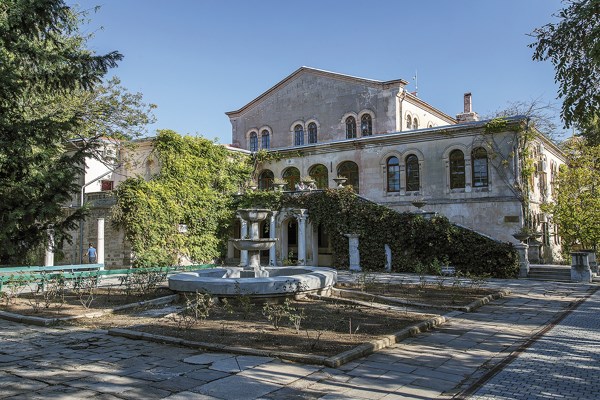 Until now historians have been arguing about the circumstances and exact date of Prince Vladimir’s baptism. They agree only in one thing: after a long siege Korsun (another name for Chersonesus in ancient Rus’) was captured by Prince Vladimir who threatened the Byzantine imperial brothers Basil II "Bulgaroktonus" (Bulgar-slayer) and Constantine VIII to campaign against the King-City (Byzantium), unless they bless him to marry their sister Anna. The Basileus put forward one condition: the wedding will take place only if Vladimir gets baptized. The prince agreed and, having returned to Kiev with a young wife and Greek priests, tackled the baptism of his subjects.
Until now historians have been arguing about the circumstances and exact date of Prince Vladimir’s baptism. They agree only in one thing: after a long siege Korsun (another name for Chersonesus in ancient Rus’) was captured by Prince Vladimir who threatened the Byzantine imperial brothers Basil II "Bulgaroktonus" (Bulgar-slayer) and Constantine VIII to campaign against the King-City (Byzantium), unless they bless him to marry their sister Anna. The Basileus put forward one condition: the wedding will take place only if Vladimir gets baptized. The prince agreed and, having returned to Kiev with a young wife and Greek priests, tackled the baptism of his subjects.Incidentally, the relic of Saint Clement treasured in the cathedral church of Chersonesus springs up in our story again at this point. Vladimir took with him the head of Saint Clement to his homeland. In Kiev this relic was most likely kept in the Church of Tithes and obviously perished in a terrible conflagration, when Khan Batu desolated the capital city in 1240.
And two decades earlier Chersonesus also fell under the strikes of Genghis Khan’s hordes and here the fire destroyed the Russian mission which, archaeologists believe, was located not far from the most beautiful “1935 basilica” (the object was named by the time of excavations) whose remnants can still be seen on the northern shore of Chersonesus. During the excavations of this quarter a kiotny cross with Slavonic inscriptions and silver Novgorod grivnas was unearthed. Probably, Russian merchants settled down in this district…
The history of Chersonese Taurica that followed is one of long years of decay and desolation. Weakened by the never-ending standoff against Mongols and Seljuk Turks, the city eventually became the booty of enterprising Genoa, whose fortified trade outposts were strung out from the Azov to Mediterranean regions. Ancient Chersonesus actually was transformed into a Genoese colony, though the city did not last long in this capacity. In the 15th century the Ottoman Empire put an end to it and already in the 16th century Martin Broniewski, a Polish envoy to the Crimean khan Mehmed II Geray thus depicted Kherson: “… This city is empty, inhabitable, representing just ruins and desolation. Houses are razed to the ground and lie in ashes…”
Fog bell
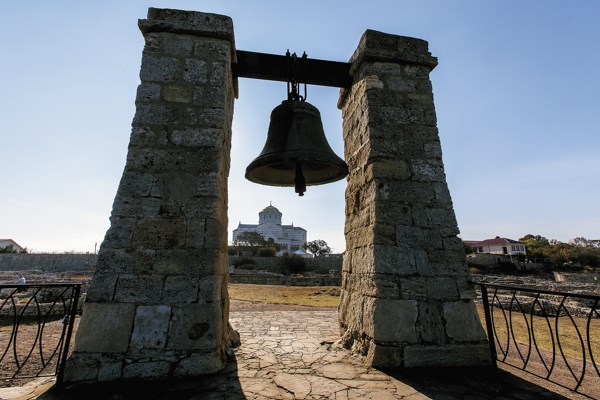 The main symbol of Chersonesus and Sevastopol stands at the edge of a cliff: the signal bell, more often called the fog bell: prior to the early 1960s its chime on foul weather reminded the sailors that they could be threatened with nearby rocks. Like everything else in Chersonesus, even this bell has its unusual story to tell.
The main symbol of Chersonesus and Sevastopol stands at the edge of a cliff: the signal bell, more often called the fog bell: prior to the early 1960s its chime on foul weather reminded the sailors that they could be threatened with nearby rocks. Like everything else in Chersonesus, even this bell has its unusual story to tell.It was cast in 1778 from remolded trophy Turkish canons and served faithfully in one of the Taganrog churches, but was eventually presented to St. Vladimir Monastery in Chersonesus, created in 1850 at the initiative of Archbishop of Kherson and Taurus Innocentius (Borisov). The Eastern War that broke out soon after and the siege of Sevastopol ended in Chersonesus being captured by French troops. The bell as a booty was taken to Paris where, as the legend goes, it was mounted on the Belfry of Notre Dame de Paris. Negotiations about its return dragged on for many years and only in 1913 it was finally repatriated. And after the monastery was closed in 1925, the bell became a fog bell.
Its last ordeal came during the heroic defense of Sevastopol in the years of the Great Patriotic War, and traces of bullets and shell fragments can be seen found on the bell…
Someone once circulated a stupid rumor that the foggy bell fulfills all wishes: you simply need to make a wish and hit the bell with a stone. Plenty believe it’s worth a try. In spite of the sign hanging nearby: “Please, do not throw stones at the bell!” – occasionally a short and abrupt ring can be heard over the ancient ruins of Chersonese Taurica.
Author: Lada Klokova




